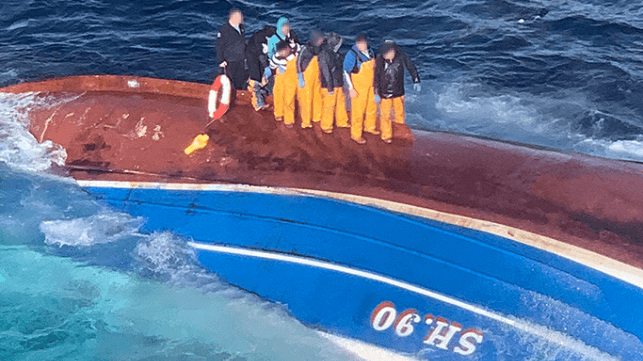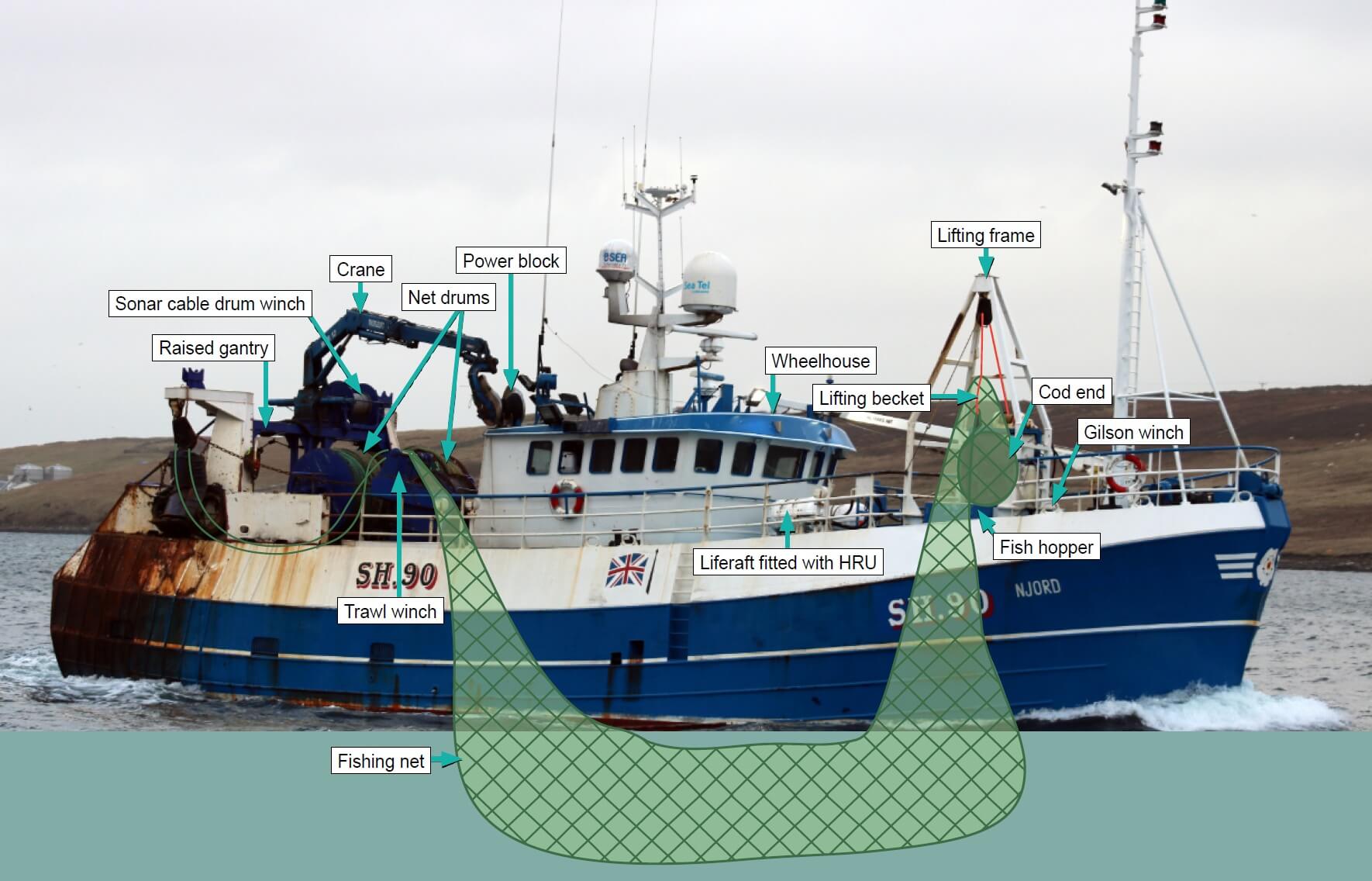MAIB: Open Drain Caused Deadly Capsizing in North Sea

MAIB has published its final accident investigation report into the capsizing and foundering of stern trawler Njord, which went down about 50 nautical miles north-east of Peterhead, Scotland in 2022. MAIB found that post-construction modifications had reduced the vessel's initial stability, and that a large haul of fish was enough to capsize the vessel.
On March 5, 2022, the 27-meter Njord departed Peterhead to fish in the Norwegian sector of the North Sea, with a crew of eight on board. In the early hours of the following morning, Njord arrived at a position about 130 nautical miles north-east of Peterhead and put out its fishing net over a gas pipeline from the Sleipner A gas platform. The vessel towed its net along the pipeline until 1100, when the net was hauled in. The catch was the largest the crew had ever seen, the equivalent of roughly 30 tonnes of fish.
Njord was a 1992-built trawler with a setup not commonly found in high-seas fisheries. Her net reels were at the stern, but recovery of the catch occurred on the starboard bow. The cod end had to be hauled up over the starboard rail using a winch and lifting frame, and then the fish were fed into a hatch in the foredeck for processing.
 Courtesy MAIB
Courtesy MAIB
This time around, the catch was 30 times as abundant as usual. The crew towed the cod end around to the starboard side using a power block, then used a loop of line and a winch to haul up about one tonne of fish at a time into the hopper on the foredeck. After about ten lifts and ten tonnes in the hopper, the Njord had a list of about 10-15 degrees. The crew went below to start processing the catch.
Within an hour, they had only processed and stowed about three tonnes of the fish, and the skipper wanted to move more quickly. He ordered them to haul up more of the catch and fill the hopper again. Two more lifts went well enough, but on the third lift, the vessel took on a heavy list from the weight of the fish hanging from the net reel and the winch on the bow.
As the list increased, the Njord began to downflood, and the situation changed very rapidly. Despite efforts to cut loose the net, the Njord slowly rolled over to starboard, and the crew escaped by climbing out onto the port side of the hull and walking up onto the upturned keel. For floatation, they had only one life ring for eight people, and no immersion suits. None of the life rafts popped to the surface; it is likely that they were all caught in the vessel's rigging and deck gear.
The vessel's EPIRB self-activated at about 1340, and the Norwegian Coast Guard launched a response. A SAR helicopter dispatched from the Johan Sverdrup oil platform arrived on scene at about 1416 and stood by as the OSV Olympic Challenger approached to conduct a surface rescue. As the Challenger prepared to launch its fast rescue boat, the Njord suddenly began to sink from beneath the survivors' feet. Within moments, all eight fishermen were in the water: six who were hanging on to one lifering, and two who were attempting to swim to stay afloat.
The SAR helicopter crew deployed their rescue swimmer to try to save the two men who had nothing to hang onto. The first fisherman to be hoisted up was retrieved alive, though he was briefly unconscious and had ingested water and diesel. The second was pulled up six minutes later. By the time the rescue swimmer got to him, he had sunk below the surface, and he was retrieved in an unresponsive state. Despite medical attention he did not recover.
The SAR helicopter recovered one more survivor from the life ring group, then headed for shore; the Olympic Challenger's fast rescue boat saved the last five survivors.
In 2021, before the casualty voyage, the Njord had been modified with the addition of two prawn net reels and an icemaker towards the stern, but no evaluation was made of the effect on stability. MAIB reconstructed the vessel's stability based on the best available figures, and found that the vessel may have failed the test on one of seven standard loading conditions (though the findings were not definitive).
Additionally, MAIB found that progressive flooding began rapidly through an unapproved and undocumented drain pipe that had been installed through a watertight bulkhead on the starboard side. Assuming that the valve on the drain had been left open, modeling suggested that the passageway probably began flooding through the drain at about 17 degrees of inclination, and a load of about 4 to 7.5 tonnes on the net would have been enough to start the process.
"It is likely that Njord would not have capsized had the valve on the drain been closed, as it should have been, while the vessel was at sea," MAIB concluded.
That reduced downflooding angle, combined with the extreme luck of a 30-tonne catch, may have been enough to sink the ship - and the crew may have been willing to overlook the danger signs, especially in flat-calm surface conditions.
"It is likely that the new experience of such a large catch led the crew to perceive Njord’s heavy listing as normal under the circumstances. A large catch meant significant remuneration for all of the crew as share fishermen, and their delight might have influenced their judgment of and consideration towards safety," wrote MAIB. "Had the net been cut away immediately, and the additional fish not been added to the hopper, the vessel might have been saved."
MAIB noted that the crew were incredibly lucky that the EPIRB had floated free. The captain did not manage to get off a VHF distress call before the capsizing, and if the EPIRB had not activated itself and reached the surface, it is likely that the entire crew would have perished in the cold water.
